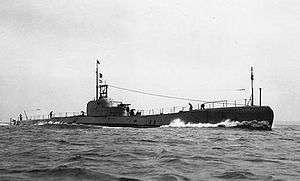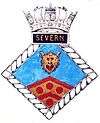HMS Severn (N57)
 HMS Severn (N57) | |
| History | |
|---|---|
| Name: | HMS Severn |
| Builder: | Vickers Armstrong, Barrow |
| Launched: | 16 January 1934 |
| Fate: | sold 1946 |
| Badge: |
 |
| General characteristics | |
| Displacement: |
|
| Length: | 345 ft (105 m) |
| Beam: | 28 ft 3 in (8.61 m) |
| Draught: | 15.9 ft (4.8 m) |
| Propulsion: |
|
| Speed: |
|
| Complement: | 61 |
| Armament: |
|
HMS Severn (N57) was an ocean-going type of submarine of the River Class. She was built by Vickers Armstrong, at Barrow, and launched on 16 January 1934. She was completed on 12 January 1935.[1]
Construction
At the time of launch the River class were the fastest submarines afloat. They were powered by 10,000 h.p diesel engines for surface operations and electric motors for submerged operations giving top speeds of 22.5 knots (41.7 km/h) and 10 knots (19 km/h) respectively. She carried a complement of 60 crew and was armed with a 4-inch (102 mm) gun, two machine guns and six torpedo tubes for 21 inch (533 mm) weapons. The tonnage of the Severn was 1,850 on surface and 2,710 when submerged.
Service history
The outbreak of the Second World War found Severn in the Mediterranean with the 1st Submarine Flotilla stationed at Malta. In September 1939 she was transferred to West Africa, stationed at Freetown, to act as convoy escort guarding against surface raiders.[1]
In March 1940 Severn returned to home waters and was employed on interception patrols in the North Sea. This involved searching for U-boats, surface raiders and blockade runners, and she was active in this capacity during the Norwegian campaign. In May 1940, she sank the Swedish sailing vessel Monark, which had been taken into German service.
In May 1941 Severn was reassigned to Gibraltar with the 8th Submarine Flotilla. During this period she made several patrols in the western Mediterranean, and she also sailed with HG 69 as ocean escort In June 1941 Severn fired upon an Italian Argonauta class submarine and later sank the Italian merchants Polinnia and Ugo Bassi. In August, she attacked an unidentified submarine.[2][3][4]
She was one of a number of submarines ordered to track the German battleship Bismarck before her eventual sinking.
In 1942 Severn returned to home waters, where she employed again on interception duties.
In May 1943 she returned to the Mediterranean to join the naval operations leading up to the invasion of Sicily (Operation Husky). Following this she was stationed at Haifa, and took part in relief operations to the garrison at Leros during the Aegean campaign.[1]
In January 1944 Severn was assigned to the Eastern Fleet, joining 2nd Submarine Flotilla at Trincomalee in May. There she took part in interception patrols in the Indian Ocean. This continued until the end of hostilities with Japan, in August 1945.
Disposal
VJ-Day found Severn in Ceylon, where she was paid off and decommissioned. Having survived the Second World War and was sold for breaking up in 1946 to T. Hassanally, of Bombay.[1]
Notes
- 1 2 3 4 GB Mason, HMS Severn at naval-history.net
- ↑ This was according to the crew of "The Severn" the Italian submarine "Bianchi" and was sunk 0n 7th August 1941. The Torpedo was from the No 4 Tube.
- ↑ HMS Severn, Uboat.net
- ↑ Medallion presented to the crew.
References
- Colledge, J. J.; Warlow, Ben (2006) [1969]. Ships of the Royal Navy: The Complete Record of all Fighting Ships of the Royal Navy (Rev. ed.). London: Chatham Publishing. ISBN 978-1-86176-281-8. OCLC 67375475.
- GB Mason HMS Severn at naval-history.net
- G Helgason HMS Severn at uboat.net